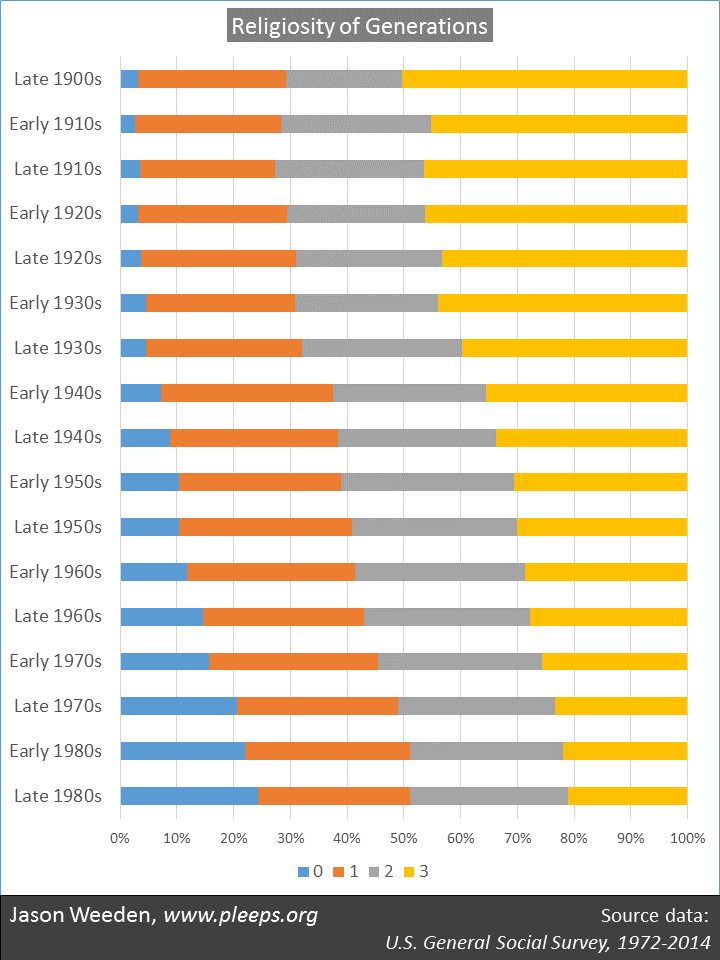Stories appear pretty regularly about the decline in U.S. religiosity. Usually the data come from either downward trends in church attendance or upward trends in religious “nones”—that is, people who say “none” or “atheist/agnostic” or “nothing in particular” when asked about their main religious identity or affiliation.
I got curious about what this really involves and decided to check the long-term trends in the U.S. General Social Survey (GSS). I combined information on religious attendance and “nones” into a single overall religiosity measure.
The main empirical issue is the age-period-cohort one. We know that the U.S. adult population is made up of less religious folks now than it was, say, 10 or 20 years ago. But how has this occurred? Is it mostly about religiosity declining for everyone over time, as, say, many folks who used to go to church have now stopped? Or is it mainly cohort/generation replacement, where older and more religious generations have been dying off, replaced by younger and less religious generations? Or what?
Looking at the numbers, I find that it’s mainly cohort/generation replacement. Across the 43 years of GSS data, the linear changes within cohorts over time are really weak. That is, looking at, say, people born in the 1950s across the full range of years from 1972 to 2014, there’s little overall change in their religiosity as they age through the years—so, e.g., they have been about as religious in their 50s as they were in their 30s. But the cohort differences are pretty big—e.g., people born in the 1970s have been substantially less religious in their 30s than were people born in the 1950s. (Having said that, an important wrinkle is that most cohorts show a temporary drop in religiosity when people are in their mid-20s. These are ages where most have left their parents’ higher-attendance households but haven’t adopted their own married-with-children pattern that’s typical of mid-adult churchgoers.)
So, if you want to see the long-term trends in religiosity, mostly you want to see how cohorts differ from each other (while smoothing over the temporary mid-20s drop so as not to overestimate the difference between younger and older folks). That’s the chart below. It shows half-decade cohorts starting with people born in the late 1900s (so, born from 1905 to 1909) and ending with people born in the late 1980s (born 1985 to 1989). The different bar segments show religiosity percentages within the cohorts. Most simply: the blues are the true “nones”; the blues plus oranges are people who rarely attend services; the greys are moderately religious; and the yellows are highly religious. The long version is that the bar segments show percentages of the cohorts that: are “nones” who rarely attend religious services (the blue segments, labeled 0); have a religious identity but rarely attend services, along with a few “nones” who attend services with some frequency but not weekly (the orange segments, labeled 1); have a religious identity and attend services with some frequency but not weekly, along with a handful of “nones” who attend services weekly (the grey segments, labeled 2); and have a religious identity and attend services weekly (the yellow segments, labeled 3).
From those born in the late 1900s to those born in the early 1930s, overall there was a trend of decreasing religiosity, but not a very strong one. These cohorts were actually central players in the mid-20th century rise in religiosity. The 1950s were weird in lots of ways, and two of them involved unusually high fertility along with unusually high church attendance relative to prior and later decades.
The modern generational drop really kicked off with those born in the late 1930s. For them and every generation since, each new generation has been unambiguously less religious than the generation that came before it. There were particularly notable declines for those born in the early 1940s and those born in the late 1970s. This is a good reminder of the imprecision of generational labels. When it comes to declining religiosity, a lot of it has been laid at the feet of Baby Boomers and Millennials. Yet the faster changes actually kicked off with the folks in the second half of the Silent Generation and then again for those in the second half of Generation X.
The accumulated generational shifts are a really big deal. For those born in the early 1930s, for example, just under 5% were non-attending “nones” and around 44% were weekly churchgoers. For those born in the early 1980s, in contrast, these two extremes are essentially tied at around 22% each—“nones” increased more than fourfold while weekly churchgoers dropped by half.
An important shift over time has been in the fact that non-churchgoers are a lot more likely to identify as “nones” than they used to. For those born in the early 20th century, only around 10% or 15% of non-churchgoers were “nones”; for the late-1980s generation, in contrast, about half of non-churchgoers are “nones”. You can see this in the chart, where the blue segments (the non-attending “nones”) have been getting bigger, but the orange segments (mostly non-attending folks who nonetheless maintain a religious identity) have only shrunk a bit.
And so, when you see stories about how religiosity is declining or about how young people are less religious than older people, remind yourself that very similar stories could have been (and surely were) written 10 years ago, or 20, or 30, or 40. Of course this doesn’t mean that religiosity will necessarily keep declining across generations, particularly at the rate it has been. The thing is, you never know when something like this might start leveling out, or even if we could have another period like the 1950s where we see sudden reversals in secular trends. So even though religious decline has been happening for a while, it’s always actually interesting news to find out that it’s still happening.

